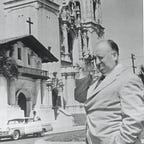Unit 4: Early Christianity, Liturgy, and the Aesthetic
At Mission Dolores Basilica I am part of the RCIA team. My favorite part about being on the team is partaking in the journey of our catechumens from the first meeting to the culmination of their initiation into the Church at the Easter Vigil. In recent years, before COVID-19, we have actually had few families go through the RCIA process. The sacrament of Baptism is the crucial first step of one’s faith journey entering into a relationship with Jesus Christ. In reading Robin Jensen’s Baptismal Imagery in Early Christianity, one is able to comprehend the rituals, symbols and images of Baptism. I wish to explore three dimensions: the scrutinizes, the catechumens’ incorporation into the community, and baptism as a dying to oneself and a rising to Christ. I believe that because our parish has intentionally focused on these specific dimensions our faith community has been blessed by their testimonials and strengthened other families’ faith.
Lent is an intense period of preparation called in RCIA “Period of Purification and Enlightenment’’. This period includes reflections on what is stopping them from being fully immersed in Christ and what personal sins need to be cleansed. Jensen mentions that, “catechumens…. regimen included daily exorcism. As the day for baptism drew close , the bishop performed this rite so that he personally could be assured of their purity…commanding all the evil spirits to flee and not return…thus freed from demonic powers and servitude to sin”(32). In relating this to today, at the parish our RCIA team of catechists and sponsors take great effort in working with our catechumens in preparing for the scrutiny rites with even the children participating, however modified. During the third, fourth and fifth Sundays in Lent the catechumens stand in front of the community to be prayed over including the exorcism rites included in the scrutinizes. The questions of thirst, blindness, and death are probed and their reflections are incorporated into the prayers of the faithful. As the celebrant and community prays over them, the catechumens’ petitions most often resonate in each of our own Lenten journeys. Just as Jensen explains, “Baptism is ritual of cleansing as well as of physical and spiritual healing”(50). This process of the rituals of the scrutinizes and exorcisms are not only moving the catechumens but the entire faithful on the path to purification.
Through baptism one is not only incorporated into the parish community, but also the larger church community, the People of God. They are being called to live the Gospel which is often counter cultural. Perhaps these neophytes are not being threatened by death from the Roman Empire but they are being called to to be part of a family that is called to surrender totally to God’s will. As Jensen states “receiving baptism undeniably required new understanding of family relationships…having a dual identity”(54). Furthermore, the RCIA team spends a significant amount of time on the lives of saints who provide a true example of what it means to be in a relationship with Christ. Through baptism one is also incorporated into the communion of saints as mentioned by Jensen, “Neophytes were also at least provisionally, incorporated into the company of saints and martyrs…The recipients of baptism thus join the martyrs, a union made even more vivid by their having been baptized in the presence of the saints’ remains”(68–69). Baptism initiates one into the larger church community, both present and past. Jensen mentions that through baptism one crosses “ a spiritual boundary, being enrolled in a group that not only offered companionship and encouragement in this life but also certain assurance of a blessed afterlife”(90).
The final dimension I wish to speak of is baptism, the dying to oneself and a rising to Christ. It is extremely important to share with the catechumens that they will experience through baptism a rebirth in Christ. Part of our RCIA process is going on a mini pilgrimage/tour of our Basilica and Old Mission churches to really acclimate the catechumens with their worship space and spiritual home. A main goal is to signal out the images that refer back to the sacrament of baptism. We show them the baptismal font in the Old Mission and the mosaic ceiling in one of the side chapels that shows the phoenix rising. This imagery connects the catechumen to the baptismal action as Jensen states that “Augustine interprets the phoenix as a symbol of resurrection of the gendered human body…echoes the theme of baptismal regeneration”(156). At our Easter Vigil in the Basilica church, the catechumens are baptized in a larger baptismal font, where they are triple immersed in the water. The triple immersion not only baptizes the catechumen to the Father, the Son and the Holy Spirit, but also symbolizes rebirth, as Jenson mentions that , “The old person had drowned in the font; the new person (newly clothed in Christ) was ready to begin new life”(165).
In conclusion, I feel that Robin Jensen’s book ,and specific attention to imagery, conveys that in baptism the person is regenerated and reborn. I feel that our parish is constantly being reborn by the neophytes and it is our hope that after the COVID-19 pandemic has ended that we will again be able to fully gather together in person and that this ministry can fully continue as before.
